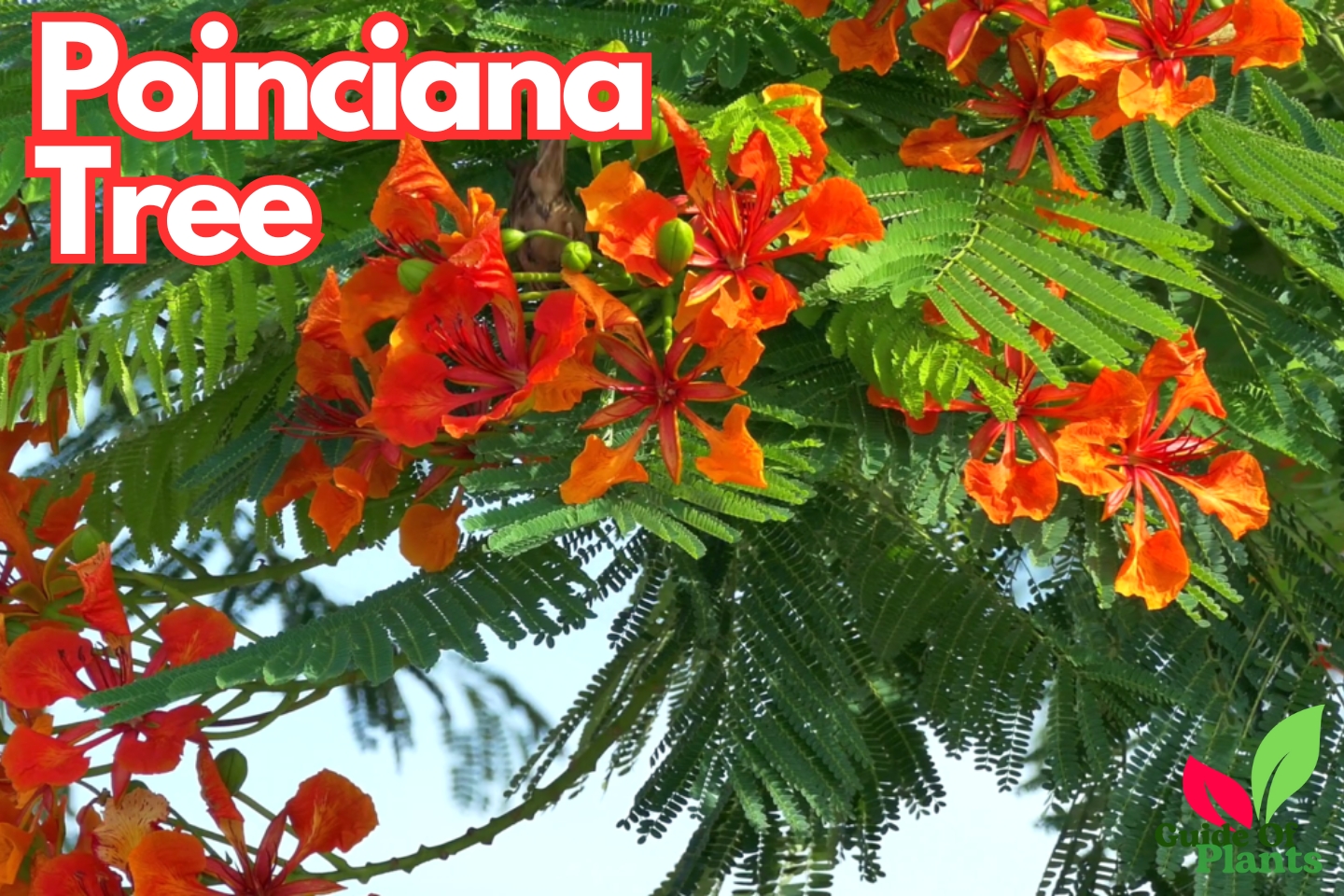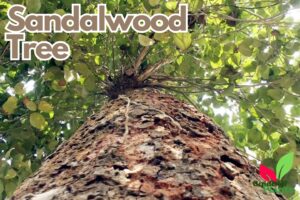The Poinciana tree, also known as Delonix Regia, is a striking tropical tree known for its bright red flowers. This tree has been widely planted in tropical and subtropical regions around the world.
Table of Contents
Scientific Background of Delonix Regia
Delonix regia belongs to the bean family, Fabaceae. It is classified in the genus Delonix, which contains around 12 species of trees and shrubs native to Madagascar. The species name regia refers to its regal appearance.
Some key facts about the scientific background of the Poinciana tree:
- It is a medium-sized tree growing to around 10-15 meters tall with a wide spreading canopy.
- The leaves are bipinnate, meaning they are divided into smaller leaflets. Each leaf contains 10-20 pairs of leaflets.
- The flowers are large and bright crimson-red in color. They have four spreading petals and measure up to 8 cm across.
- The fruit is an elongated leathery pod around 30-60 cm long containing several seeds.
- Delonix regia is pollinated by bees and requires full sun exposure. It thrives in tropical climates with warm temperatures year-round.
- It has become naturalized in many regions and can spread prolifically if not maintained. The seeds are also spread by water.
- The Poinciana is known by many common names worldwide including Flamboyant, Peacock flower, Gulmohar, and Royal Poinciana.
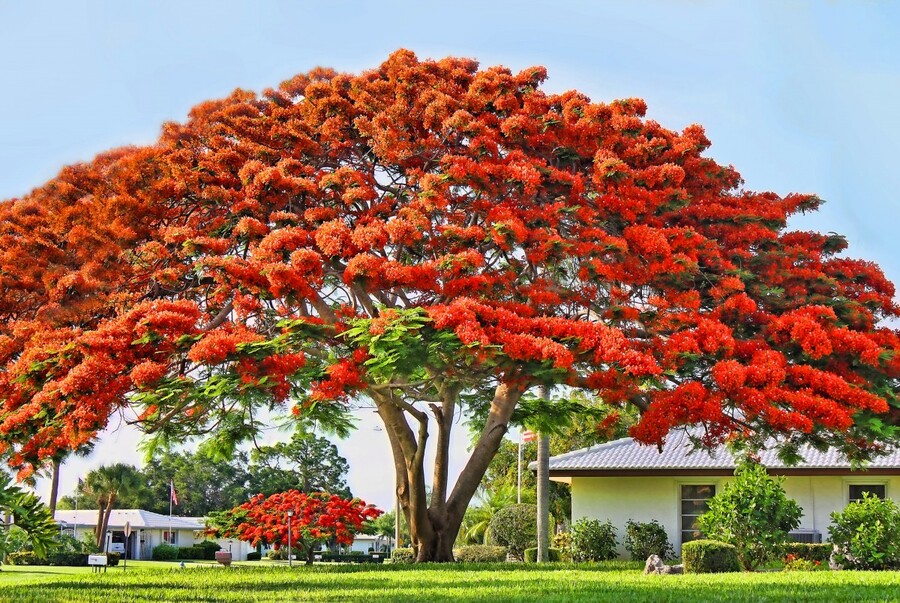
Uses and Benefits of the Poinciana Tree
The striking Poinciana tree offers several beneficial uses. Its vibrant red blooms and wide canopy provide excellent ornamental value.
Landscaping and Ornamental Value
With its flamboyant color display, the Poinciana is one of the most widely planted ornamental trees in tropical regions. It is very popular in landscaping designs due to the following merits:
- Provides ample shade with its spreading crown. The Delonix regia grows rapidly when young.
- Brightens up any landscape with clusters of scarlet blooms contrasting beautifully against the feathery green foliage.
- Tolerates pruning well. Poincianas can be trained into appealing shaped specimens.
- Adapts to various soil types and needs little maintenance when established.
Medicinal Properties
Various parts of Delonix regia have been utilized in herbal medicine including:
- The flowers contain flavonoids with antioxidant and anti-inflammatory qualities.
- Extracts from the leaves and bark have antimicrobial and antifungal compounds.
- The seeds yield oils rich in linoleic acid, oleic acid, and other fatty acids with pharmaceutical potential.
Further research is warranted on the medicinal bioactives present in this versatile Poinciana tree.
Other Uses
The Poinciana also serves some additional functions:
- The wood is useful for making low-grade timber, furniture, and pulp.
- Leaf litter decomposes rapidly, enriching the soil. It makes good mulch.
- Flowers are sometimes used for dyeing fabrics yellow and red.
The beautiful Poinciana tree Delonix regia has excellent ornamental virtues along with some medicinal and other utility benefits. It deserves wider planting given its visual appeal and hardy nature.
Origin of the Poinciana Tree
The Poinciana tree is indigenous to Madagascar, an island country off the southeastern coast of Africa. Delonix regia is believed to be endemic to Madagascar’s tropical dry forests in the western part of the island.
Several key facts regarding the origin of this species:
- It occupies river banks and open woodlands in its native habitat.
- The natural range is limited to northern and western Madagascar.
- It has been present on the island for centuries and is featured in Malagasy folklore.
- Evidence suggests Poinciana trees have existed in Madagascar since prehistoric times based on pollen records.
- The tree’s natural beauty has made it a national symbol of Madagascar.
Thus, this ornamental plant traces its origin solely to the island of Madagascar where it has long been a distinctive part of the landscape.
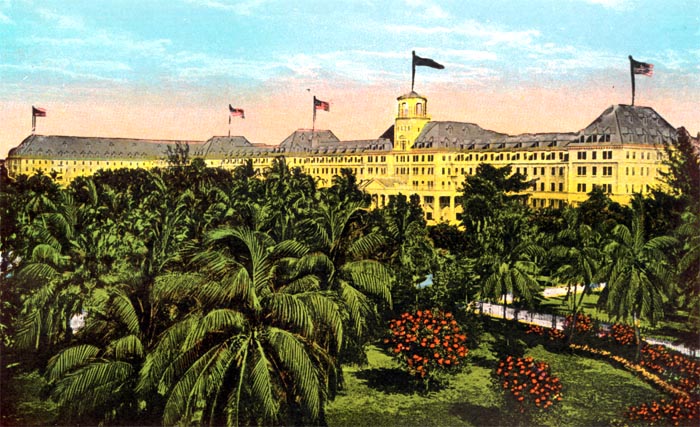
History of the Poinciana Tree
The Poinciana entered cultivation in the 1700s when the French introduced seeds from Madagascar to the Pondicherry Botanical Garden in India. In 1793, seeds were sent from India to the Caribbean island of Martinique. From there, the tree spread across tropical regions. Key events include:
- Reached Jamaica in 1807 and Florida in the late 1800s where it became naturalized.
- Hawaii started planting Poincianas in the mid-1800s after seeds arrived from Jamaica.
- Earned the name Royal Poinciana due to its splendor. It began decorating royal botanical gardens.
- Widely exported during the colonial era by the British across their trade routes.
Today the iconic Poinciana tree adorns tropical cities worldwide thanks to centuries of cultivation and propagation.
Also Know About:
- Sandalwood Tree: A Nature’s Gift for Health, Beauty, and Serenity
- The Monkey Puzzle Tree A Living Fossil
- The Strangler Fig Plant A Wonderful Creation Nature
- Discover The 3 Main Types of Forest Trees You Must Know
Outlook of the Poinciana Tree
The Poinciana is instantly recognizable thanks to its vibrant flowers and elegant, fern-like foliage. These medium-sized tropical trees reach up to 10-15 meters tall at maturity and develop a wide, spreading crown. The bipinnate leaves are made up of 10-20 pairs of tiny leaflets, giving them a lacy, delicate appearance. The smooth gray bark flakes off in papery patches.
Beginning in early summer, eye-catching clusters of bright red blooms emerge in abundance from the branch tips. The four-petaled flowers can grow as wide as 8 centimeters across and create a spectacular floral display set against the green foliage. Flower color ranges from fiery orange-red to crimson depending on climate and genetics. The blooms eventually give way to long, bean-like seed pods up to 60 centimeters in length.

Poinciana Tree Appearance
- Has a spreading, umbrella-shaped canopy with gracefully drooping branches. Feathery, elegant bipinnate leaves with 10-20 pairs of small leaflets. Smooth gray bark that can flake off in papery pieces. Poinciana Tree Size
- Matures to 10-15 m tall and wide in ideal conditions. Grows rapidly when young, up to 2 m per year. Eventually reaches a broad, rounded shape. Poinciana Tree Flowers & Colors
- Produces eye-catching clusters of vivid red flowers. Each flower has four spreading, wavy petals up to 8 cm wide. Blooms throughout summer in tropical climates. Flower color ranges from bright orange-red to crimson.
- The Poinciana is classified in the genus Delonix which contains around 12 species, all native to Madagascar.
- It belongs to the bean family Fabaceae like many other tropical trees that produce pods.
- The compound leaves can have up to 40 leaflets in some varieties. Each leaflet is just 2-3 cm long.
- New leaves emerge in a beautiful red or orange color before maturing to green.
- The tree’s wide canopy provides ample shade and can spread as far as it is tall.
Care for the Poinciana Tree
Providing appropriate care enhances the health and flowering performance of Poinciana trees. These fast-growing trees require heavy pruning periodically to maintain their umbrella shape and open habit. Overlapping, crossed, or inward facing branches should be removed. Pruning is best done after flowering concludes to avoid removing next season’s flower buds.
Poinciana need ample water while establishing but can tolerate short periods of drought once their root systems mature. They thrive in fertile, well-draining soil and require good drainage to prevent root rot. A light application of balanced fertilizer in early spring and summer benefits growth and flowering. Over-fertilization should be avoided as it leads to excessive leggy growth at the expense of blooms.
- Overwatering is detrimental and causes root rot leading to branch dieback. Allow soil to partially dry out between waterings.
- Young trees need staking until they develop a sturdy trunk able to support their broad canopy.
- Very adaptable to soil types but prefers a pH between 6.0-7.5. Does not tolerate salinity.
- Flowering is reduced if temperatures drop below 50°F.
Caring Tips
Proper care enhances the Poinciana’s health and flowering.
Pruning Poinciana Trees
- Tolerates heavy pruning. Remove overlapping or inward facing branches.
- Limit pruning right after flowering to avoid removing next season’s flower buds.
Water Requirements
- Needs regular irrigation until established.
- Mature trees are moderately drought tolerant once roots are developed.
Soil Needs
- Thrives in fertile, well-draining soil. Sandy or loamy texture is ideal.
Fertilization
- Apply balanced fertilizer in early spring and summer.
- Avoid over-fertilizing which causes leggy growth.
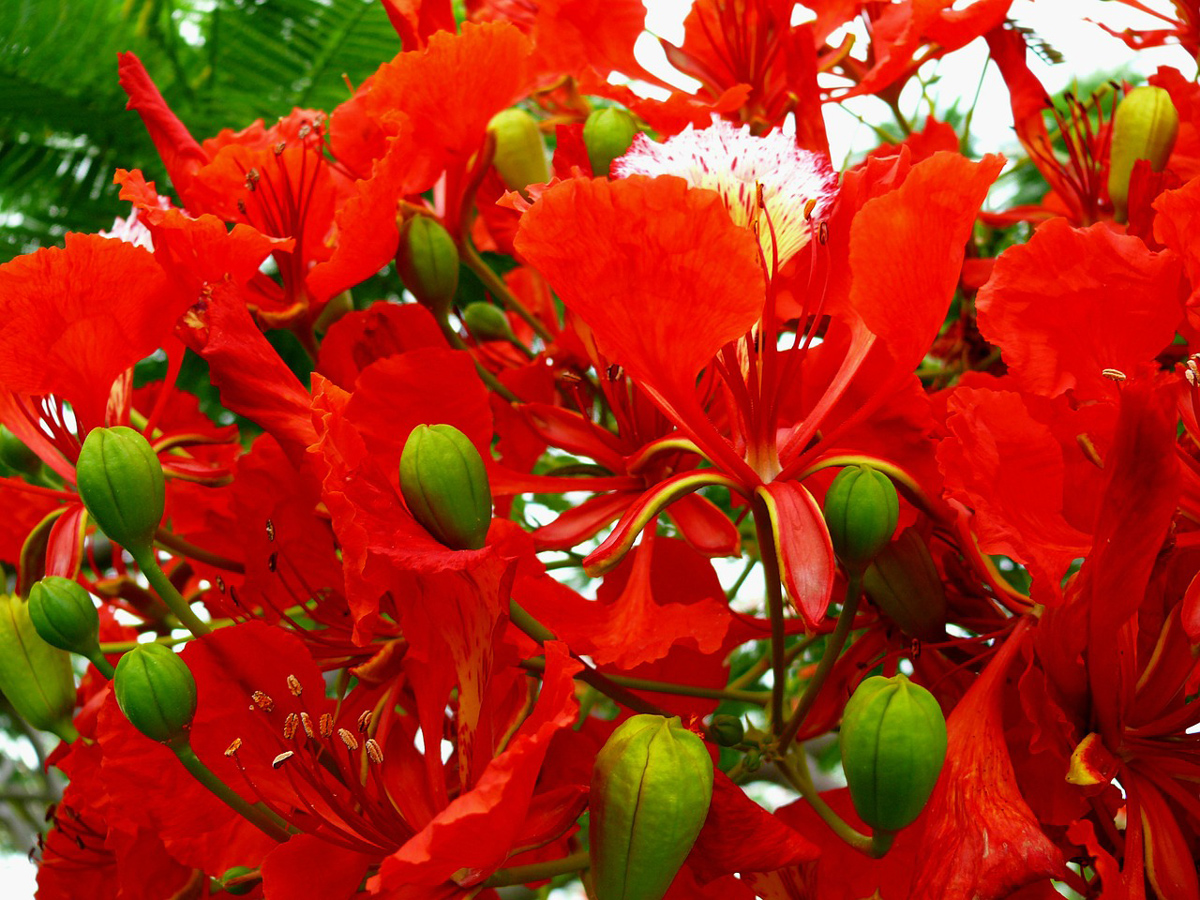
Growing the Poinciana Tree
Poinciana trees can be easily propagated from seeds or cuttings. Seeds should be collected from fresh ripe pods in late summer or fall once they turn brown. After extracting and cleaning the seeds, they can be planted in pots or directly outdoors. Soaking the seeds for 24 hours speeds up the germination process which takes 1-2 weeks. The seedlings grow quickly under warm, humid conditions.
Cuttings taken from young branches 10-15 cm long also root readily in potting mix. Root hormone can be applied to the cut ends to encourage root growth. With bottom heat and intermittent misting, the cuttings should be well-rooted within 4-6 weeks. Poincianas grow from cuttings flower faster than seed-grown trees. Once the young trees reach about 60 cm tall, they can be transplanted into their permanent growing sites in the landscape.
Growing Tips
- Trees grown from cuttings produce blooms 1-2 years earlier than seedlings.
- Cuttings taken from flowering branches root the best. Select green flexible branches.
- Remove flowers and flower buds from cuttings to direct energy into root growth.
- Germination rates are low for seeds over 1 year old. Viability lasts only about 3 years.
- Potted seedlings should be gradually exposed to sunlight to avoid scorching the leaves.
Some Interesting Facts About the Poinciana Tree
The Poinciana is an intriguing tropical tree that has accumulated some fascinating stories and qualities over centuries of cultivation. As one of the most widely grown ornamentals in tropical regions, it has become part of local traditions and folklore.
One of the most iconic sights in tropical areas is the Poinciana’s vibrant red blooms carpeting the ground underneath the tree’s spreading canopy. The tree sheds its spent flowers and leaves rapidly, creating a stunning carpet of color below. Poincianas are sometimes referred to as “flamboyant” trees thanks to their flamboyant floral displays.
In areas like Hawaii and the Caribbean, the Poinciana is a beloved part of the landscape. Its history is intertwined with local customs. Poinciana wood was traditionally used to make canoes in Hawaii. The trees are planted near homes in Puerto Rico to ward off evil spirits. Poinciana flowers are used in traditional medicines and dyes across various cultures.
The Poinciana has the rare distinction of being named the national tree of two different countries – Madagascar, its native home, along with Vietnam, where it has naturalized after introduction. It is one of only a handful of non-native plants to be honored as national tree.
Delonix regia trees are known to live over 100 years in ideal tropical environments. The massive tree in Hawaii’s Foster Botanical Garden is estimated to be over 150 years old. It has a trunk circumference of 7.9 meters and a canopy spread of 12 meters, testimony to the tree’s longevity.
Poincianas exhibit an unusual flowering habit called cauliflory where the flowers emerge directly from the main trunks and branches rather than at the tips. This allows the tree to produce hundreds of blooms even at a young age compared to other flowering trees. The coloration of the flowers also varies remarkably based on location from vivid orange-red to deep crimson.
The Poinciana found its way into botanical gardens worldwide thanks to its royal connections – seeds were spread by French, British, and Dutch colonists through their trade networks. Today it brings unmatched tropical flair whether gracing the avenues of Havana or the waterfronts of Sydney and Cape Town.

Conclusion
The vibrant Poinciana tree has earned a special spot amongst ornamental tropical plants. Its royal connections trace back centuries to its discovery in Madagascar and later propagation across the tropical colonies of European powers. Today it brings majestic beauty to tropical regions around the world where its blazing flowers and lacy green leaves have become iconic symbols of the tropics.
The Poinciana has integrated itself into the very cultural fabric of tropical locales. Its history is intertwined with local folklore and traditions everywhere from Hawaii to the Caribbean. People have forged strong connections to this exotic import from Madagascar.
While widely planted for its visual grandeur, we are still uncovering the many uses of the Poinciana’s parts. Its flowers, leaves, seeds, and sap have applications from traditional medicines to modern pharmaceutical research. There is still much to learn about the bioactive compounds produced by this botanical treasure.
Looking to the future, the Poinciana will continue spreading beauty and local pride. Climate change may expand its range even further. Shortages of water and urbanization pose some threats to its prevalence. However, the Poinciana’s hardy nature and human affection should ensure it remains an iconic fixture enhancing tropical regions for generations to come.
Few ornamental plants can match the Poinciana’s mix of elegance, utility, history, and natural appeal. It is sure to beautify the tropics for centuries more with its regal rainbow of exuberant color. The Poinciana tree reigns supreme as the queen of the tropics.

